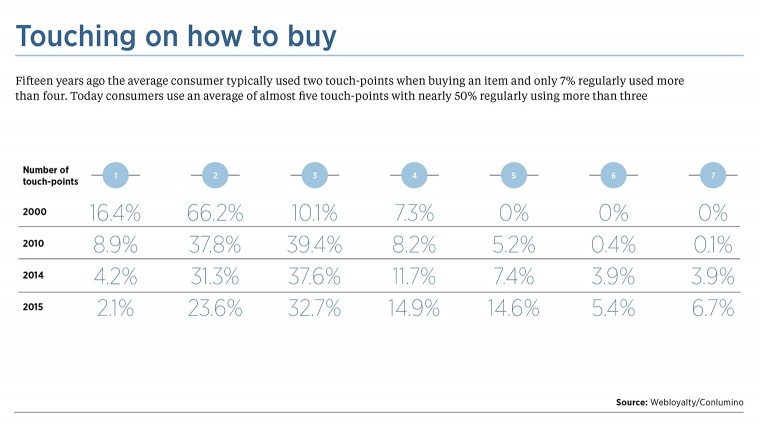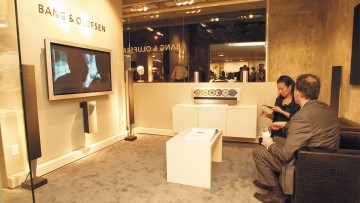It’s one of the most popular retail buzzwords, yet only 29 per cent of UK retailers consider themselves to be omni-channel, providing a seamless shopping experience across different channels.
Research from software company JDA and PwC also found that for 64 per cent of UK retail chief executives the top priority to enable growth is improving omni-channel and fulfilment capabilities.
Digital performance firm Dynatrace works with 17 of the top 20 global retailers, helping them to improve the performance of their web and mobile storefronts. Their research shows that nearly a third of UK consumers shop through a combination of online, mobile and in-store channels. More than half (56 per cent) use their smartphone to compare prices online or download discount vouchers while shopping in-store.
This means, says Michael Allen, Dynatrace’s solutions vice president, retailers must ensure their customers receive a consistent experience regardless of which channel they shop through. “Every customer journey is unique in today’s digital business economy,” he says. “The rise of online and mobile commerce has fundamentally changed the way we shop, but it’s not as clear-cut for retailers as just identifying whether their customers shop online or in-store.”
Mr Allen says the multitude of touch-points in the modern consumer journey puts pressure on retailers to ensure their customers enjoy a consistent experience across every channel. “Whether they’re visiting the website from home to research a product, using the mobile app to ‘click and collect’ the item on their way into work or walking into their local high street branch to pick something up in person, the journey has to run smoothly, or retailers risk causing disillusionment that pushes their customers away,” he says.
Of course, as they become progressively digitalised, retail operations are at increased risk of technical failure.
“Many critical processes and online storefronts are interdependent or rely on third-party services such as web hosting or cloud-computing providers,” Mr Allen points out. “Unfortunately, when one of those third parties has a problem, it can prevent staff from putting through a sale at the checkout or pull down an entire website, rendering them slow or even completely unusable.
“This creates a major challenge for retailers in creating a consistent customer experience across all channels, as their performance can easily be impacted by factors outside of their direct control.” He says that retailers need complete, real-time visibility into the entire application and service-delivery chain for every customer interaction and every business process on the back-end to see where and why issues might be occurring.
It’s also worth noting that an over-reliance on a particular third-party service is a recipe for disaster for any retailer, says Mr Allen. “If a website-hosting provider goes down, there should be a failsafe built in that switches the service over to an alternative provider instantly, so customers don’t suddenly find themselves unable to access the site or proceed to the checkout halfway through a shop,” he says.
It still happens more than it should. A common error, says Mr Allen, is when a web page has a single point of failure, where one faulty component can delay the entire page from loading. “From the customer’s perspective, they’re stuck in a situation where their browser is just left hanging for 20 seconds or more before anything appears, during which time most will have given up and clicked off,” he says.
Another error is building too many marketing analytics tools into a single page. Many of them do the same thing and merely create another component adding to the page-load time. Having too many images that load separately on a single page can also have a negative impact on the customer experience; everything will load much faster for the user if images are grouped into a single file using sprites, but this is often neglected during web-page design, adds Mr Allen.
There are a number of technologies transforming the omni-channel landscape. PowaTag, used by the likes of Universal Music and Carrefour, aims to turn every point of contact into a sale, converting impulse into purchase and eliminating the wait that causes incomplete transactions. The technology turns offline environments and printed materials into online shopping environments, and printed materials and posters into accountable sales vehicles. PowaTag audio even embeds audio watermarks into any live or recorded broadcasts, letting consumers purchase spontaneously and immediately.
There is a lot of customer-centric hype and it fails to consider business operations realities and the sizeable investment a retailer will have to make to implement an omni-channel strategy
Dan Wagner, chief executive of Powa Technologies, says: “Real value is what defines consumer patterns. Consumers are looking to make informed purchases that can be completed via their smartphones easily and securely. Being constantly bombarded by individual mobile commerce and payments applications has only complicated further an already saturated market. Users experience the same frustrations looking at their smartphones being overcrowded with apps of limited scope and reach as looking at their wallets or pockets being full of credit and loyalty cards that can only be used in certain stores.
“Users do not want one more app – they need the right tool that provides real solutions to their needs.”
But chief executive of retail software company RetailPro International Kerry Lemos warns against simply jumping on the latest bandwagon. “The high expectation for omni-channel already exists in the consumer world,” he says. “Whether retailers should choose to go through the operational upheaval to conform to that expectation is still to be determined.”
In fact, the most important question they must ask is whether omni-channel is worth it for their business. As Mr Lemos says: “Consumers want omni-channel because it is convenient for them. There is a lot of customer-centric hype and it fails to consider business operations realities and the sizeable investment a retailer will have to make to implement an omni-channel strategy.”
In order for the omni-channel experience truly to work, the whole company has to be engaged in the idea. “The retailer must set their own definition and standard for omni-channel – not the customer, not the media, not other businesses. It is important not to get carried away with the hype, but instead determine what is best for their business,” he says.
“Every retailer’s business model, goals and offerings are different, and that will be reflected in how they structure their omni-channel efforts. The entire company, from the chief executive to the weekends-only shop assistant, must be implementing the omni-channel vision in every decision and interaction.”
So, what does the future of omni-channel look like? Rob Shaw is global vice president, general business and systems, applications and products customer engagement and commerce at hybris, which provides omni-channel solutions to companies such as P&O Ferries and Monsoon. He says we’ll start to see more “listening in” in real time to the signals a specific consumer generates while browsing across different channels, then acting in a timely fashion, rather than basing next steps on customer history.
“Let’s say a customer is browsing a retailer website a month or so after buying a new pair of shoes,” he says. “Typically this might result in the brand’s marketing technology generating adverts for shoes that then follow the customer around the web. By applying context, the retailer would realise faster that the customer is probably more interested in shoe accessories than another pair of shoes, leading to more appropriate recommendations or advertisements for products such as laces, shoe polish or protective sprays.”
Implementing omni-channel retail strategies is the only way that this context can be derived as, in the age of the channel-hopping consumer, it provides all the data required to build the all-important single view of the customer. Historically, too many retailers have been guilty of employing a siloed approach when it comes to the organisation of their business, a situation that makes accurately tracking customer activity all but impossible.
But this is changing, says Mr Shaw: “Many brands are implementing more holistic approaches to their operations and more effective, contextually-aware customer engagement will be the key benefit.”
CUSTOMERS HEAR THE DIFFERENCE AT BANG & OLUFSEN STORES
Luxury audio brand Bang & Olufsen has no trouble attracting customers, but the company’s experience isn’t quite the same as its competitors.
Paul Sands, director of retail customer experience, says although customers do some research online beforehand, they are often inspired by other B&O users or previous experience of the brand, and the majority of buyers will come in-store to experience the products.
“Customers won’t visit just once, but will come to the store a few times, sometimes even five or six, to plan a large purchase. Quite often we visit customers’ homes to help plan where the products will sit and the optimal set-up for them,” he says.
Because of this the company often contacts customers to let them know about new products they might be interested in. “It’s a very personalised retail experience,” Mr Sands adds. For its core products, the Bang & Olufsen stores are its largest channel, for its sub-brand B&O PLAY, the stores remain the largest channel, but a greater percentage of people also buy online or through third-party retailers.
This isn’t without its challenges, says Mr Sands. “We operate a large retail network made up of our own stores as well as franchise retail partners, therefore we are working with many businesses in many countries which can be a challenge. But creating a great customer experience across these channels and businesses is largely about having a strong brand identity and DNA that influences all those channels.
“It is also about mapping the customer journey, and knowing how and why a customer might reach out to different channels at different times.” The key is to ensure channels are not trying to replicate each other. “The internet, for instance, has a different focus to in-store. It is also important to ensure we have the correct back-up systems in place, including communication tools and a good customer relationship management system,” he says.


